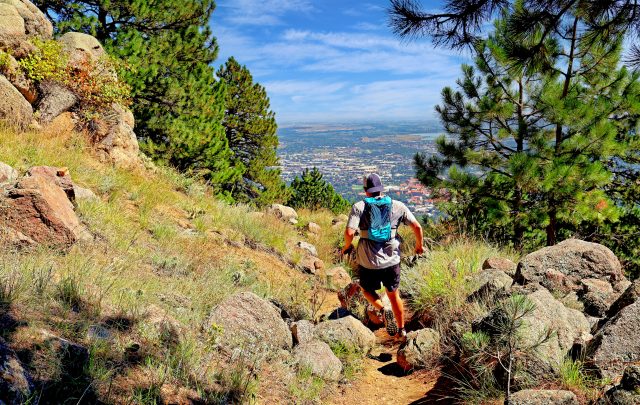
Long-distance runners often describe a sensation that happens around 40 minutes into a run. A deep sense of relaxation overcomes them, their focus zeroes in and their bodies move effortlessly without conscious thought. Pain fades into the background.
This so-called runner’s high is a state of euphoria that’s believed to be an evolutionary mechanism to improve human performance for long-distance running and hunting. According to some anthropologists, endorphins released within our brains help tune out discomfort and improve our concentration.
For years researchers have pointed to the endogenous opioid system of the human brain as the driver for this physiological mechanism. But a more recent analysis published in Proceedings of the National Academy of Sciences of the United States of America suggests it has more to do with the brain’s cannabinoid system.
A new study from the University of Colorado Boulder backs up that claim. A paper published in Cannabis and Cannabinoid Research in July explores the relationship between the runner’s high and cannabis use. The findings indicate that cannabis can actually increase the effects of runner’s high — even if it does seem to slightly decrease performance.
“We really wanted to collect some data to look at acute effects,” says Angela Bryan, the study’s lead author. “What are people feeling when they run while they’re using cannabis? And is that associated with some of the feelings of euphoria that people report as the runner’s high?”
Bryan is a professor in the Department of Psychology and Neuroscience. Her broad area of research focuses on the intersection of health and risk behavior. She says that with the legalization of cannabis, she became acutely interested in how legalization was going to affect health habits like exercise.
“It’s just sort of ballooned out from there once we found out that people use cannabis with exercise, and cannabis users are more likely to exercise than non-users,” Bryan says.
She got interested in the topic after looking at survey data showing people used cannabis to enjoy exercise more.
“One of the things that we know about exercise, in general, is people who have a more positive affective response to exercise are more likely to exercise, which isn’t rocket science: If it feels better to you, if it makes you feel good, you’re going to want to do it again,” Bryan says. “And so we were super interested in whether cannabis impacted the affective response, the extent to which you feel good or bad during exercise.”
So she and her fellow CU researcher Laurel Gibson recruited 49 study participants to get to the bottom of their questions. The participants were all cannabis users and runners between the ages of 21 and 49 years old. The researchers had them all download an app that allowed them to track their runs, and instructed them to run the exact same route, once without cannabis, and once having used some kind of commercial cannabis product. The researchers put no restrictions on how far they ran, what kind of cannabis product they used, or what dosage. They only asked that the participants do the exact same thing both times. Before and after each run the participants filled out surveys gauging their perceived experiences.
They found that when the runners used cannabis they reported, on average, significant increases in enjoyment, tranquility and disassociation, and described less perceived exertion and other side effects.
But there was one notable caveat: The cannabis runs were an average of 31 seconds per mile slower than the non-cannabis runs.
“That’s super consistent with data other folks have collected that shows performance doesn’t get better,” Bryan says. “But that [the exercise] is more enjoyable.”
Bryan adds that those effects were consistent whether participants used edibles, flower or concentrates.
Bryan says her team has a laboratory study on the same topic that is currently under review. For that study, the researchers had more control over the setting, conditions, types and quantities of cannabis that participants used, and measured their blood along the way. In the future, she wants to do more research using participants who are less experienced with cannabis.
Ultimately, Bryan hopes these findings might encourage people, especially those averse to exercise, to become more active and healthy.
“If cannabis might be a way to help people enjoy [exercise] more, to be more likely to do it, to experience less pain when they do it, I think there’s a lot of potential there,” she says.














